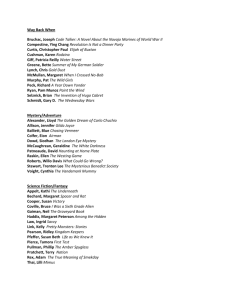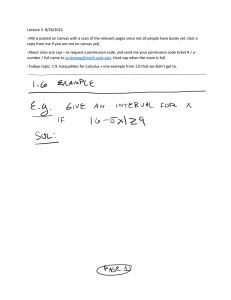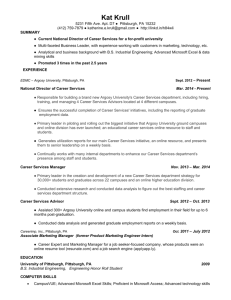Contortions of Technique: Germaine Krull`s Experimental Photography
advertisement
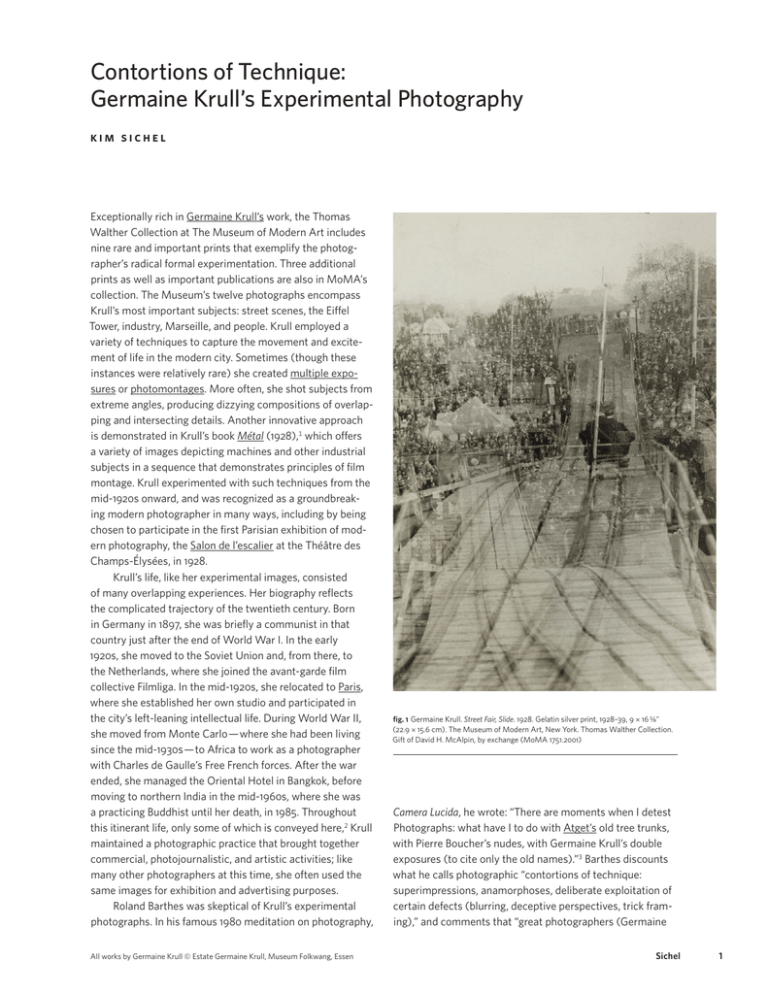
Contortions of Technique: Germaine Krull’s Experimental Photography Kim Sichel Exceptionally rich in Germaine Krull’s work, the Thomas Walther Collection at The Museum of Modern Art includes nine rare and important prints that exemplify the photographer’s radical formal experimentation. Three additional prints as well as important publications are also in MoMA’s collection. The Museum’s twelve photographs encompass Krull’s most important subjects: street scenes, the Eiffel Tower, industry, Marseille, and people. Krull employed a variety of techniques to capture the movement and excitement of life in the modern city. Sometimes (though these instances were relatively rare) she created multiple exposures or photomontages. More often, she shot subjects from extreme angles, producing dizzying compositions of overlapping and intersecting details. Another innovative approach is demonstrated in Krull’s book Métal (1928),1 which offers a variety of images depicting machines and other industrial subjects in a sequence that demonstrates principles of film montage. Krull experimented with such techniques from the mid-1920s onward, and was recognized as a groundbreaking modern photographer in many ways, including by being chosen to participate in the first Parisian exhibition of modern photography, the Salon de l’escalier at the Théâtre des Champs-Élysées, in 1928. Krull’s life, like her experimental images, consisted of many overlapping experiences. Her biography reflects the complicated trajectory of the twentieth century. Born in Germany in 1897, she was briefly a communist in that country just after the end of World War I. In the early 1920s, she moved to the Soviet Union and, from there, to the Netherlands, where she joined the avant-garde film collective Filmliga. In the mid-1920s, she relocated to Paris, where she established her own studio and participated in the city’s left-leaning intellectual life. During World War II, she moved from Monte Carlo — where she had been living since the mid-1930s — to Africa to work as a photographer with Charles de Gaulle’s Free French forces. After the war ended, she managed the Oriental Hotel in Bangkok, before moving to northern India in the mid-1960s, where she was a practicing Buddhist until her death, in 1985. Throughout this itinerant life, only some of which is conveyed here,2 Krull maintained a photographic practice that brought together commercial, photojournalistic, and artistic activities; like many other photographers at this time, she often used the same images for exhibition and advertising purposes. Roland Barthes was skeptical of Krull’s experimental photographs. In his famous 1980 meditation on photography, All works by Germaine Krull © Estate Germaine Krull, Museum Folkwang, Essen fig. 1 Germaine Krull. Street Fair, Slide. 1928. Gelatin silver print, 1928–39, 9 × 16 ⅛" (22.9 × 15.6 cm). The Museum of Modern Art, New York. Thomas Walther Collection. Gift of David H. McAlpin, by exchange (MoMA 1751.2001) Camera Lucida, he wrote: “There are moments when I detest Photographs: what have I to do with Atget’s old tree trunks, with Pierre Boucher’s nudes, with Germaine Krull’s double exposures (to cite only the old names).”3 Barthes discounts what he calls photographic “contortions of technique: superimpressions, anamorphoses, deliberate exploitation of certain defects (blurring, deceptive perspectives, trick framing),” and comments that “great photographers (Germaine Sichel 1 fig. 2 Germaine Krull. Photographs reproduced in Edmond Gréville. “Fêtes foraines” (Street fair). Vu, no. 4 (April 11, 1928). Collection International Center of Photography Krull, Kertész, William Klein) have played on these surprises, without convincing me, if I understand their subversive bearing.”4 But while such photographs are sometimes subversive, to be sure, they are often celebratory in tone. Krull and her colleagues carried out their “contortions of technique” to produce metaphors for the swirling, confusing, exhilarating urban life in their post–World War I decade. Multiple Exposures and Photomontages The most unusual Krull work in the Walther Collection is the multiple exposure Street Fair, Slide (1928; fig. 1). Depicting a roller-coaster ride at a Parisian street fair, the picture was published in the fourth issue of Lucien Vogel’s weekly illustrated newspaper Vu, in an article titled “Fêtes foraines” (Street fair) (fig. 2).5 Noted author Edmond Gréville’s text for “Fêtes foraines” expresses the joy and mayhem of street fairs: “Above all, I love the grand fairs of Paris, because the mixed orchestras are the most cacophonous, the charlatans most talkative, the crowds larger. A street fair is the democratic bath of poetry.”6 Krull contributed six images to the story. In addition to Street Fair, Slide, she provided pictures of the Ferris wheel, the scene outside the “fat lady” show, the crowds, and the merry-go-round. Street Fair, Slide takes up most of the first page of the two-page article. Its caption highlights the fair’s noise and chaos: “The popularization of air travel, full of vertiginous sensations, can be paralleled here by the scenic railway. While waiting, people who cannot afford an airplane ride experience with joy the crazy descents of this favorite brutal attraction.”7 To construct the multilayered print, Krull shot several straight photographs of the fair ride; these can be found in collections in Vienna and Essen.8 She took the pictures from several different positions while standing at the top of the ride. As Lee Ann Daffner, photography conservator at MoMA, has speculated, Krull, a wild and adventurous soul, would almost certainly have taken the ride herself.9 Krull’s image conveys the dizzying experience of the ride, which brought passengers down a rickety, undulating path, then up an uphill segment. Krull took one photograph standing at the top right of the rails, another at the track’s top left, and a third from yet another vantage point, this time with a more dramatically tilted camera angle. Some elements (a lamppost and carousel in the distance and a tent at the end Sichel 2 fig. 3 Germaine Krull. Plate 51 in Métal. Paris: Librairie des arts décoratifs, 1928. The Museum of Modern Art Library, New York of the ride) appear three times, while the rails, lined with rows of lightbulbs, crisscross the image. At the center of the composition is what appears to be a double exposure of a boy sitting in the roller-coaster cart: in one instance, looking forward; in the other, looking left. When MoMA photography conservator Hanako Murata and I closely examined the image by microscope, however, we saw that there are actually two boys — one sitting behind, and with his arms wrapped around, the other. Still, the effect is that of one figure doubled in time and in space, the image recalling Anton Giulio Bragaglia’s experimental Futurist photography. The composition of Street Fair, Slide is completely disorienting. The rails descend in several different directions, metaphorically derailing the riders and crashing them into the large crowds below. Details are printed in varying densities so that they become ghostlike overviews on top of the spectators. We know that the Walther Collection Street Fair, Slide print is not the one reproduced in Vu, since on its verso there are no agency or Vu stamps, just Krull’s, and no cropping marks (which it would have had, since the view seen in the magazine is slightly less expansive). Therefore, we are certain that Krull produced at least two prints of Street Fair, Slide. Theoretically, she could have created her layered composition in four different ways. She could have made it as a multiple exposure within her Ikarette 6 by 9 centimeter (2 ⅜ by 3 9/16 inch) camera, repeatedly exposing a single negative. We know she did not, however, because one of the layered images was produced in reverse, by flipping over the negative. Second, she could have made each of her final prints as a unique work by exposing the three negatives separately, one after the other, onto the sheet of photographic paper; that approach has been ruled out, since the Walther Collection print and the Vu image have identical overlaps. Third, Krull could have created a single print using the approach just mentioned, photographed it, and printed copies using the new negative. The quality of information in the copies, however, would be slightly degraded and conservators have ruled that out as a possibility: the details of the people and scenery are too distinct, and microscopic examination reveals none of the dust spots or fuzziness that secondary prints contain. This leaves only one possibility: that Krull sandwiched her three negatives together (either taping them or placing them between two pieces of glass), and produced at least two different prints from the combination: the one sold to Vu and the one now in the Walther Collection. Street Fair, Slide stands out as an important and unusual Krull photograph for several reasons. First, of the relatively few multiple exposures that Krull made during her career, it is by far the most complex. Her book Métal contains only two multiple exposures, one showing two overlapped power generators (fig. 3) and the other several layered bicycle parts printed at right angles to one another to create an effect of circular motion (fig. 4). Krull also experimented with photomontage, as in a Parisian view that superimposes a bridge, a modern industrial building, and the Palais Royal.10 She sometimes used her multiple fig. 4 Germaine Krull. Plate 22 in Métal. Paris: Librairie des arts décoratifs, 1928. The Museum of Modern Art Library, New York Sichel 3 fig. 5 El Lissitzky (Lazar Markovich Lissitzky). Record (Rekord). 1926. Gelatin silver print, 10 ½ × 8 13/16" (26.7 × 22.4 cm). The Museum of Modern Art, New York. Thomas Walther Collection. Gift of Thomas Walther (MoMA 1766.2001). © 2014 Artists Rights Society (ARS), New York/VG Bild-Kunst, Bonn fig. 6 Paul Citroen. Metropolis (City of My Birth) (Weltstadt [Meine Geburtsstadt]). 1923. Gelatin silver print, 1923–30. 8 × 6" (20.3 × 15.3 cm). The Museum of Modern Art, New York. Thomas Walther Collection. Gift of Thomas Walther (MoMA 1651.2001). © Paul Citroen/Artist Rights Society (ARS), New York/Pictoright, Amsterdam exposures and photomontages in her advertising work. One fashion advertisement combines at least three negatives, one of a frontally viewed face, another of a silk-clad back, and the third depicting two front-facing women in dresses.11 Another advertisement, from Krull’s years in Monte Carlo, is a photomontage that served as a publicity poster for two actors.12 Still another is a publicity image combining fifteen views of her subject’s hands, surrounding his seated, seemingly three-legged figure.13 Other photographers in the 1920s and early 1930s experimented with multiple exposures, and some of their prints can be found in the Walther Collection. Most important among these is El Lissitzky’s Record (Rekord) (fig. 5), made in 1926 by superimposing a photograph of a runner with a long nighttime multiple exposure of New York City’s theater district made in 1924 by Knud Lönberg-Holm.14 As Maria Gough has written, Lissitzky used the “power of advertising” to support communist causes.15 Krull, however, had no such agenda; she had left her radical communist beliefs behind in the early 1920s and was happy enough with the commercial world. On a technical level, Krull’s Street Fair, Slide is more complex and less legible than Lissitzky’s image; his kind of photomontage message is meant to be comprehensible in large-scale photomurals. However, the artists shared a belief in the power of the popular press and photography to reach the masses. Paul’s Citroen’s Metropolis (City of My Birth) (Weltstadt [Meine Geburtsstadt]) (1923; fig. 6), also in the Walther Collection and published in László Moholy-Nagy’s book Malerei, Fotografie, Film (Painting, Photography, Film; 1925),16 is a more kaleidoscopic example of a composition combining multiple urban images. Whereas Krull shot her own photographs for her combinatory works, Citroen collaged found images — cut from dozens of postcards and newspapers — and then photographed the glued-together composition. Citroen’s found images are relatively static, showing buildings from different cities, including famous structures such as the U.S. Capitol building, the Eiffel Tower, and New York’s Flatiron Building. It is the collage process that brings them to life. Krull’s images, by contrast, embody city life and movement in themselves. She depicted crowds and participated in the activities she recorded — climbing, walking, and talking with the people in her views. Placed beside Krull’s vibrant and kinetic Street Fair, Slide, Citroen’s photograph looks inhuman. Krull was not, of course, the only photographer in these years to create photographic works that layer human figures and city imagery. For a 1926 picture (fig. 7), Georgii Zimin Sichel 4 fig. 7 Georgii Zimin. Untitled (Montage with Self-Portrait and Building). 1926. Gelatin silver print, 1926–30, 3 11/16 × 3 ¼" (9.4 × 8.3 cm). The Museum of Modern Art, New York. Thomas Walther Collection. Gift of Thomas Walther (MoMA 1920.2001) Renowned for his innovative layout design, Vogel shared Krull’s interests in layered imagery, and he sometimes published her works in an overlapping fashion that honored the vertiginous quality he admired in her Métal imagery. Her contribution to the first issue, which appeared in a story on the mi-carême (mid-Lent) carnival in Paris, was one of three overlapping images at the bottom of the page.18 Her photograph shows a double-decker bus — with the label Saint-OuenBastille — from which a mustached figure in an antiquated military costume leans out, while children peer out the window. (The other two images on the page are, respectively, a photograph of a masked carnival performer taken by Eli Lotar and an anonymous picture of a circus ox.) Krull’s Street Fair, Slide, which, as mentioned above, appeared in the fourth issue of Vu, was published in a similar layout style: overlapping its top edge is an image showing a clown leaning out over a crowd to lure customers in. The members of the clown’s audience intrude on the roller-coaster scene; the large heads above and tiny, multiplied heads of the crowds below produce a compelling formal juxtaposition. The third Krull image on the page is small but brilliant and reads almost like a montage, depicting, amid its composition, a framed poster of the fat lady. The lady seems about to throw off her scarves and walk out from the frame, the busker standing nearby holding up a sheet as if to cover her. The dark superimposed his face over the exterior of a neoclassical train station facade, shot at a diagonal angle, with people standing about outside or walking along the street — and seemingly on his face. In some ways, it comes close to the appreciation of urban life that Krull demonstrates in Street Fair, Slide, but her roller coaster is more vernacular, more dangerous, and more immediate than the calm face in Zimin’s work. In 1903, the German sociologist Georg Simmel wrote of the overstimulation of city life in rapidly modernizing Europe: “The psychological foundation, upon which the metropolitan individuality is erected, is the intensification of emotional life due to the swift and continuous shift of external and internal stimuli.”17 Simmel could not have asked for a better illustration of his notion of the city as an overwhelming place — full of loud sounds, bright lights, and glaring impressions of the crowd — than Krull’s Street Fair, Slide. Krull in the Popular Press Krull had contributed to Vu since its inaugural issue, in March 1928. Vogel’s innovative instincts and hiring of interesting photographers marked Vu as a cutting-edge journal from the outset. With few picture agencies to choose from in Paris at that time, he directly commissioned his photographers, and Krull was one of his favorites, due to his admiration for photographs she had taken in Rotterdam for Métal. fig. 8 Germaine Krull. Photographs reproduced in Florent Fels. “Dans toute sa force” (In full force). Vu, no. 11 (May 31, 1928) Sichel 5 gaping hole of the entrance to the show is both eerie and alluring. Eugène Atget photographed similar shopfronts and fair attractions in Paris, but Krull’s image is more dynamic and cacophonous than Atget’s works. Krull’s most renowned photographs are not street scenes but abstracted views of the Eiffel Tower, and three of these images, accompanied by a short text by Florent Fels and laid out in overlapping fashion, appeared in a Vu article titled “Dans toute sa force” (In full force) published in May 1928, just before the tower’s fortieth birthday (fig. 8).19 According to Krull’s memoirs, Vogel told her, “Go and photograph the Eiffel Tower, Germaine. Photograph it as you really see it, and make sure that you don’t bring me a postcard view.”20 As Krull wrote, she did not see much in the “dead old form” until she began climbing the staircases and experiencing the tower from various vantage points. Some of the resultant images — vertiginous views of the wroughtiron structure — appeared in the German magazine UHU and Philippe Lamour’s journal Grand’route as well as in Vu, and others (eleven in all) grace the pages of Métal.21 Very few vintage prints from the Eiffel Tower series have survived.22 An untitled print in the Walther Collection (fig. 9) is a rare and beautiful example. The image demonstrates how Krull was able to explore montage ideas in fig. 9 Germaine Krull. Untitled (Eiffel Tower). 1927–28. Gelatin silver print, 1927–39, 9 × 6 ¼" (22.9 × 15.9 cm). The Museum of Modern Art, New York. Thomas Walther Collection. Gift of Thomas Walther (MoMA 1750.2001) single straight photographs. Here, she adopted an unusual point of view — similar to those of Moholy-Nagy, who shot worm’s-eye, bird’s-eye, and close-up views of his subjects — aiming her camera straight up the center of the tower, capturing in one view the structure’s two transportation systems: the spiraling staircases and the elevator. The iron beams and patches of light create a dynamic pattern of black and white, producing the effect of an ascending vortex in which the metalwork appears to accelerate skyward. In the bottom third of the photograph, seemingly laid over the iron scaffolding at a skewed angle, is a wall with a decorative bas-relief. Thus, we see four structural systems at play — stairways, elevator, beams, and wall — in one image. Krull shot similar experimental images in cities other than Paris. The Walther Collection includes two such works, both published in her 1935 book, Marseille. 23 One is a view of buildings along a quay in Marseille (fig. 10); Krull took the photograph at a steep downward angle through the wire rope cables of Marseille’s famous transporter bridge. The second (MoMA 1748.2001) is a bird’s-eye view of a different group of buildings. The bridge-and-quay image was beautifully and carefully printed, either by Krull herself or by one of her studio assistants. She seems to have hand-cut both of the Marseille prints, which are similar but not identical in fig. 10 Germaine Krull. Marseille. June 1930. Gelatin silver print, 1930–39, 8 ⅜ × 6" (21.2 × 15.3 cm). The Museum of Modern Art, New York. Thomas Walther Collection. Gift of Thomas Walther (MoMA 1749.2001) Sichel 6 fig. 11 Germaine Krull. Rails. c. 1927. Gelatin silver print, 15 ⅞ × 10 ⅜" (39.2 × 26.3 cm). The Museum of Modern Art, New York. Horace W. Goldsmith Fund through Robert B. Menschel size. The Walther Collection’s print of the quay photograph is cropped differently from the one reproduced in Marseille. In the latter, we see a clock in the upper right-hand corner, which anchors the composition. In the more abstracted Walther print, Krull has cropped out the clock altogether, shifting the view slightly downward and more left. The image was clearly important to Krull; she reproduced it (without clocktower) in her 1930 Gallimard monograph.24 The bridge was a very popular subject and was photographed as a symbol of modernity by multiple photographers, including Herbert Bayer, Tim Gidal, Lotar, and Moholy-Nagy.25 Métal and Filmic Montage For Krull, metal was the most powerful metaphor for the modern world, and her book Métal includes many of the industrial forms she saw in Europe. It features both multiple exposures and straight images, and the entire volume is structured according to the principles of film montage. As noted earlier, Krull was a member of the Dutch avant-garde film collective Filmliga, which was cofounded by Joris Ivens, who in 1927 became her husband. Both of them published work in Arthur Lehning’s related avant-garde journal i10. They saw screenings of Soviet avant-garde films by Vsevolod Pudovkin and Sergei Eisenstein, and Krull made a portrait of Eisenstein when he visited Paris in 1930. Eisenstein’s theories of montage were particularly important to the couple, and Krull’s Métal serves to demonstrate them. She actively adopted the Soviet filmmaker’s ideas of rupture and “visual counterpoint,” involving graphic, planar, volumetric, and spatial conflicts.26 The book is technically an album, with sixty-four numbered but unbound collotype reproductions that can ostensibly be rearranged at will. There are no captions and no identifying markers, and the images include both vertical and horizontal compositions. In a brief note beneath an introductory text by Florent Fels, Krull tells us that these photographs include a lifting bridge over the Meuse River in Rotterdam (also the subject of Ivens’s renowned avant-garde montage film, The Bridge [De Brug], from that same year); the cranes in the Amsterdam port; the Eiffel Tower; Marseille’s transporter bridge; and other industrial forms she found.27 But it would be difficult to decipher these subjects from the photographs themselves. Although there are eleven Eiffel Tower images in the book, for example, they are often so abstracted that the subject is unidentifiable, and none are on contiguous pages. MoMA’s collection includes a photograph from Métal titled Rails (c. 1927; fig. 11).28 Of Krull’s prints from the 1920s and 1930s, this one, at 15 ⅞ by 10 ⅜ inches (39.2 by 26.3 centimeters), is the largest I have ever seen. Conservators have confirmed that it is a vintage print from the period. It is unclear why Krull made such a large print. We have no knowledge of whether she made large prints for the Salon de l’escalier exhibition in Paris in 1928, for the Film und Foto show in Stuttgart in 1929, or for other exhibitions in which she participated in the late 1920s, and the back of this print has no exhibition stamps or other clues. Regardless, it is a spectacular work. Scholars have often read Métal as a purely formal experiment, but Krull used it as a commentary on contemporary life, producing the kind of montage that her friend Walter Benjamin championed, in which “the superimposed element disrupts the context in which it is inserted. . . . The discovery is accomplished by means of the interruption of sequences. Only interruption here has not the character of a stimulant but an energizing function.”29 The quality of interruption, according to Benjamin, differentiates truly revolutionary work from the mere aping of the modern world, an approach that he scornfully attributes to the work of Albert Renger-Patzsch.30 For Krull, interruption could occur in a multiple exposure, as in the aforementioned Métal image depicting overlapping views of bicycle parts. Or interruption can be found while turning a book’s pages, moving from a drive-belt detail to ominously large-scale cargo cranes, or from the Rotterdam Bridge over the Meuse to a detail of a centrifugal speed governor. Whether portraying a roller coaster, documenting the Eiffel Tower, or creating her book of industrial fragments, Krull engaged the decade’s cacophony and used provocative experimental techniques to capture its allure. Sichel 7 notes 1. Germaine Krull, Métal (Paris: Librairie des arts décoratifs, 1928). Preface by Florent Fels. 2. For a full overview of Krull’s career, see Kim Sichel, Germaine Krull: Photographer of Modernity (Cambridge, Mass.: MIT Press, 1999). 3. Roland Barthes, Camera Lucida (New York: Hill and Wang, 1981), p. 16. 4. Barthes, Camera Lucida, p. 33. 5. Edmond Gréville, “Fêtes foraines,” Vu, no. 4 (April 11, 1928): 92–93. Images by Germaine Krull. Vu was published from 1928 to 1940. Before serving as Vu’s editor, Lucien Vogel had been editor of the Gazette du bon temps and Jardin des modes, and was the art director of Vogue from 1922 to 1925. 6. “J’aime sûrtout les grandes fêtes de Paris, parce que les orchestrophones mélanges sont plus cacophoniques, les charlatans plus loquaces, le people plus nombreux. Une fête foraine, c’est le bain démocratique des poètes” (Gréville, “Fêtes foraines,” p. 92). Translated by the author. 7. “La vulgarisation des voyages en avion, fertile en sensations vertigineuses, enlèvera, d’ici quelques années, bien de l’attrait au scenic-railway. En attendant, les gens qui ne peuvent s’offrir de promenade aérienne se livrent avec joie aux descents folle de cette attraction favorite et brutale” (Gréville, “Fêtes foraines,” p. 92). Translated by the author. 8. A similar but riderless view can be found in the Christian Brandstatter collection in Vienna, and another, with riders standing at the top, is owned by the Museum Folkwang in Essen. 9. Another vertiginous Krull image in the Walther Collection (Untitled [Rue Auber, Paris], 1926– 28; MoMA 1752.2001) was taken from behind the rooftop sign of an antiques business in Paris. Krull must have climbed out onto the mansard roof to shoot from this precarious point of view. 10. Paris (n.d.), Collection Le Clezio, Paris; reproduced in Sichel, Germaine Krull, p. 175. 11. Etude (n.d.), Collection A. Jammes, Paris; reproduced in Sichel, Germaine Krull, p. 156. 12. Jules and Julien (n.d.), Germaine Krull Nachlass, Museum Folkwang, Essen; reproduced in Sichel, Germaine Krull, p. 157. 13. Pal Rab (1929), Archive and Museum of the Socialist Labor Movement, Ghent; reproduced in Sichel, Germaine Krull, p. 158. 14. Maria Gough, “El Lissitzky: Architectures of Everyday Life,” in Matthew S. Witkovsky, ed., Avant-Garde Art in Everyday Life: Early Twentieth-Century European Modernism (Chicago: Art Institute of Chicago; and New Haven: Yale University Press, 2011), p. 82. For more information on the making of this work, see Klaus Pollmeier, “El Lissitzky’s Multilayer Photographs: A Technical Analysis,” on this website. 15. Gough, “El Lissitzky,” p. 82. 16. László Moholy-Nagy, Malerei, Fotografie, Film, vol. 8, Bauhausbücher (Munich: Bauhaus, 1925); reprinted as Painting, Photography, Film (London: Lund Humphries, 1969). 17. Georg Simmel, “The Metropolis and Mental Life” (1903), in Gary Bridge and Sophie Watson, eds., The Blackwell City Reader (Chichester, U.K.: WileyBlackwell, 2002), p. 11. 18. “La mi-carème à Paris,” Vu, no. 1 (March 21, 1928): 4. 19. Florent Fels, “Dans toute sa force,” Vu, no. 11 (May 31, 1928): 284. Images by Germaine Krull. 20. Germaine Krull, “Click entre deux guerres” (unpublished manuscript, Germaine Krull Nachlass, Museum Folkwang, Essen, 1976), p. 12. 24. Pierre Mac Orlan, Germaine Krull (Paris: Gallimard, 1930), p. 55. 25. See Le Pont transbordeur et la vision moderniste (Marseille: Musée Cantini, 1992). 26. Sergei Eisenstein, “A Dialectic Approach to Film Form” (1929), in Jay Leyda, ed., Film Form: Essays in Film Theory (New York: Harcourt, Brace, 1949), pp. 52–54. 27. Ibid. 28. The image is plate 36 in Métal. A smaller print of it exists in the collection of the Musée National d’Art Moderne, Paris. 29. Walter Benjamin, “The Author as Producer” (1934), in Reflections: Essays, Aphorisms, Autobiographical Writings (New York: Schocken Books, 1986), pp. 234–35. 30. Benjamin, “The Author as Producer,” p. 230. 21. “Protest gegen ein unmögliches Bauwerk,” UHU 4 (December 1927): 106–11; Eric Hurel, “La Confusion des arts,” Grand’route 1, no. 3 (May 1930): 71–74; and Krull, Métal, cover and pls. 2, 11, 19, 26, 28, 33, 37, 50, 54, 57. 22. The Museum Folkwang, Essen, has a beautiful group of vintage Eiffel Tower photographs by Krull, and Christian Brandstatter’s collection of photographs from the Viennese picture agency Schostal holds many as well. 23. Germaine Krull, Marseille (Paris: Editions d’histoire et d’art, Plon, 1935). Text by André Suarès. Citation: Kim Sichel. “Contortions of Technique: Germaine Krull’s Experimental Photography.” In Mitra Abbaspour, Lee Ann Daffner, and Maria Morris Hambourg, eds. Object:Photo. Modern Photographs: The Thomas Walther Collection 1909–1949. An Online Project of The Museum of Modern Art. New York: The Museum of Modern Art, 2014. http://www.moma.org/ interactives/objectphoto/assets/essays/Sichel.pdf. Sichel 8
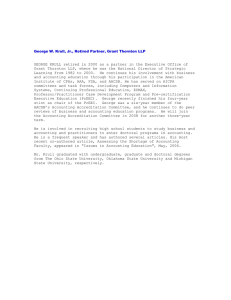
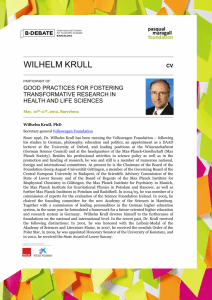
![√ 1. Let q be a prime, R = Z and... q]. Find the primes in S](http://s2.studylib.net/store/data/010491181_1-12c1abdcf573057c81f53ce2532c9451-300x300.png)
